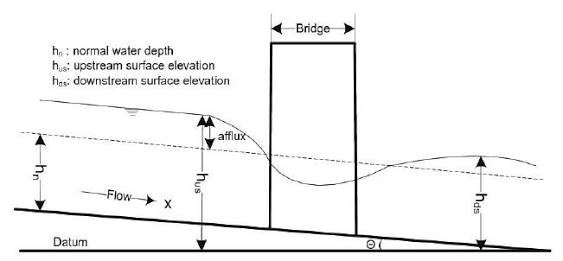The use of hydraulics is a crucial component of bridge design. Essential components of bridge hydraulics include a fair estimate of flood levels, the maximum flood discharge anticipated to occur at the bridge site throughout the bridge’s design life, and the maximum scour levels. Structures may fail if these parameters are determined incorrectly. During hydraulics Calculations should be made with the following in mind:
- A cross section of the river that is accurately representative. Artificial cuts, etc. should not contaminate the cross section.
- If the location of the bridge is near an existing natural crossing, the hydraulic cross section should cross an adjacent, undisturbed natural channel. It would be beneficial to use the cross section inside 100 m U/S or D/S.
- Spill channels need to be discovered, designated, and accommodated for adequately.
- Use the appropriate coefficient of stiffness. Since the nature of the stream changes depending on the material’s qualities and the growth of vegetation, etc., the same stiffness coefficient shouldn’t be used for the bed and the banks.
- The accuracy of the calculated velocity should be evaluated in connection to the stream’s bed material, as pebbles in the stream and low flow velocity typically do not coexist.
- It is important to be aware of the possibilities of high tides and floods occurring simultaneously in tidal streams. Discharge using the conventional methods, i.e., using Manning’s formula, should be carefully calculated and compared to Inglis discharge under such circumstances.
- It is best to use discretion when deciding whether to use the computed or observed H.F.L. as the design level. Obstacles like rice fields, bunds, blocked spill channels, etc. may have an impact on the observed H.F.L. Use the higher of the two figures as the design H.F.L.
- The details of the various stages are described below.
- HFL (observed) Highest recorded flood levels. (50 years of data)
- Manning’s discharge is equal to Inglis discharge at the HFL(Inglis) Flood level.
- Manning’s discharge is equal to the Modified Inglis discharge at the HFL(Modified Inglis) Flood level.
- Ordinary flood level (O.F.L.). When a bridge clears a flood without submerging it, the flood level is at this point, and traffic will not be disrupted beyond what is reasonable.
- The maximum interruptions allowed on various road standards are as follows:- National Highways – There are no delays.
AFFLUX:
A waterway is crossed by bridges, which might have a single span or numerous spans. Piers must be built in the riverbed for a bridge with many spans. The natural flow is obstructed by these piers. When there is a significant obstacle, the water level upstream is slightly higher than it is downstream.
It is known as afflux when the level rises. Designers assess the afflux and take it into account when creating the substructure in order to keep the superstructure dry during floods.
Afflux is defined as heading up of water when they hit any obstruction. In bridges the water hit at u/s side.

